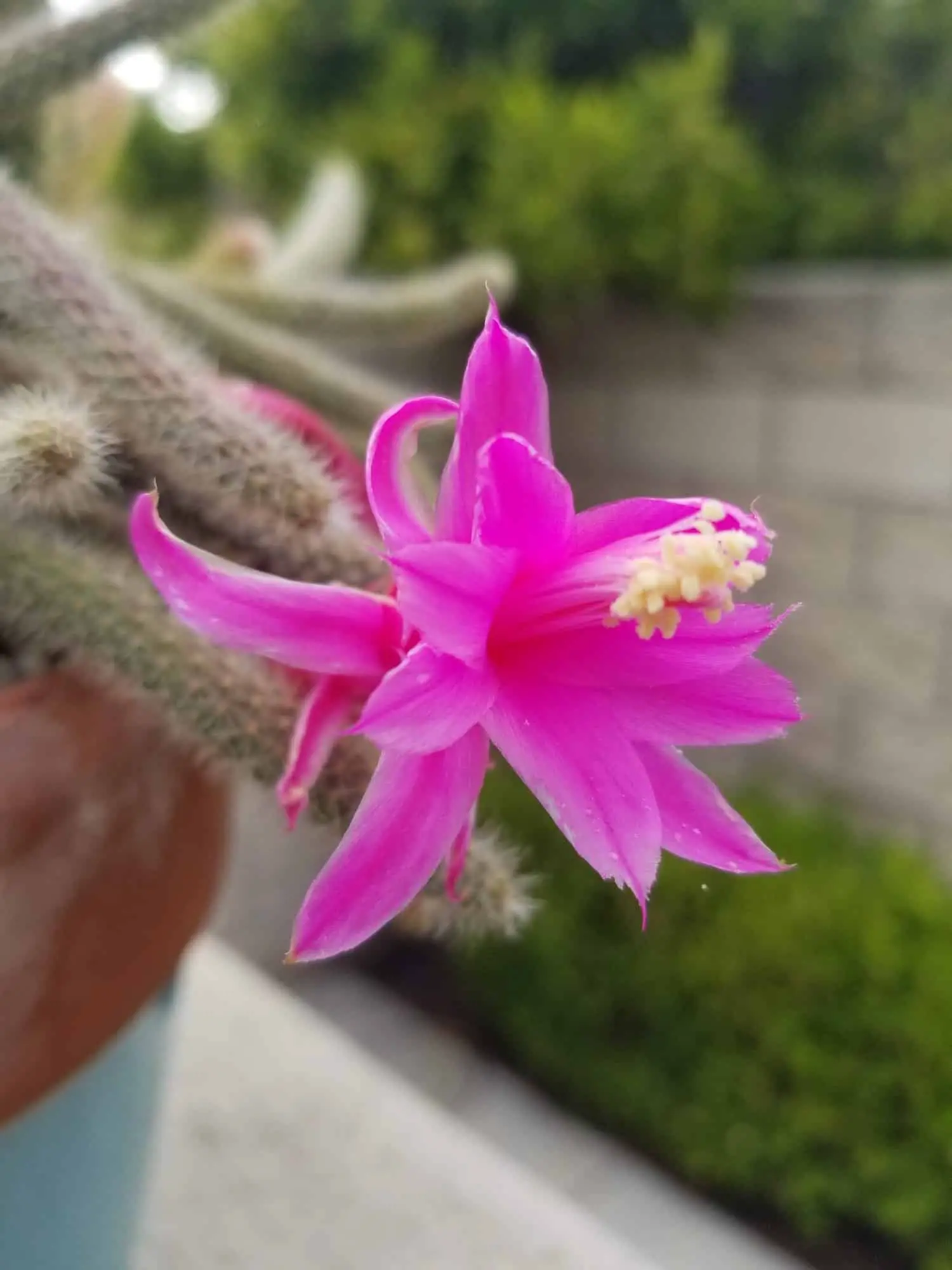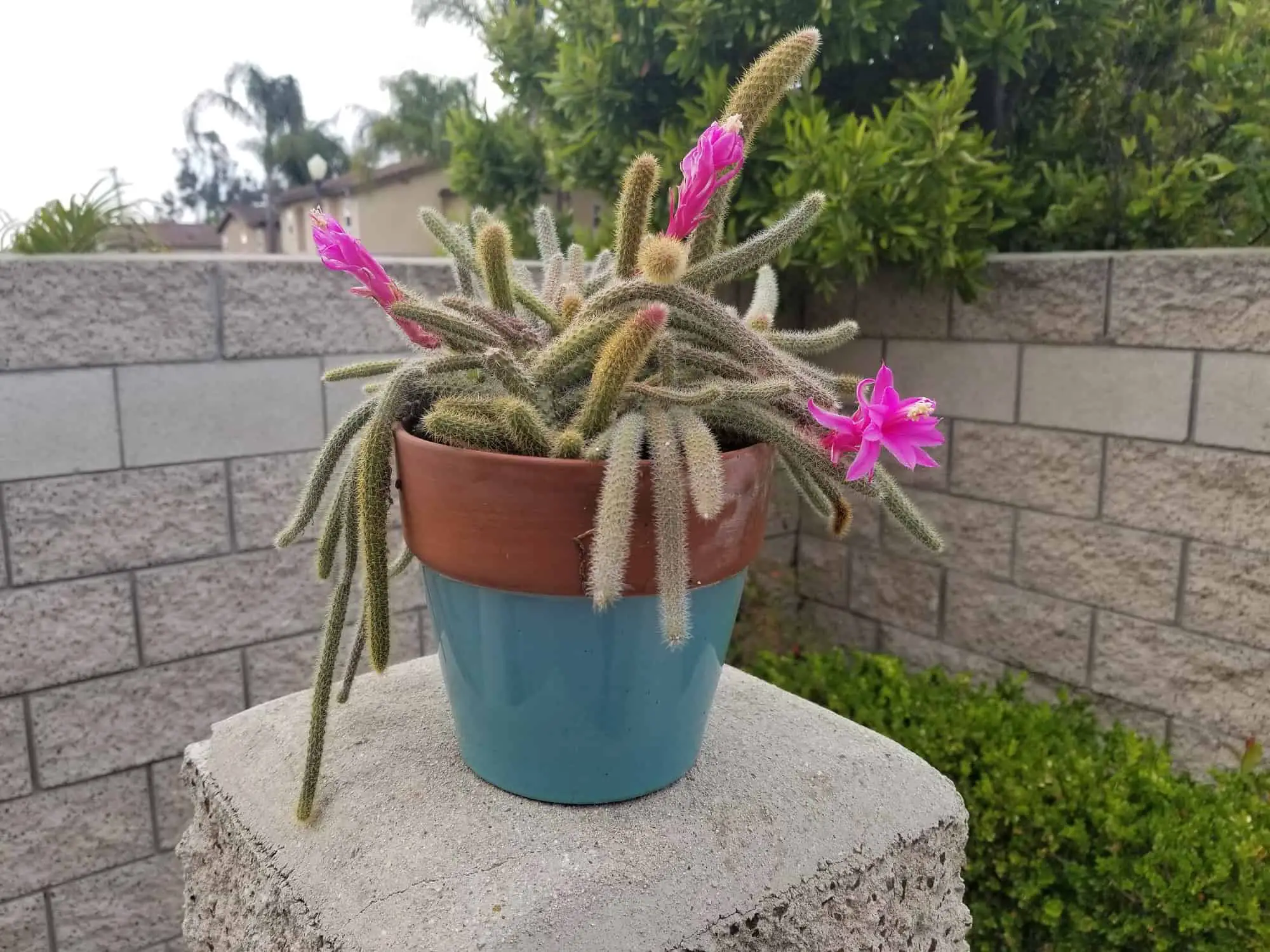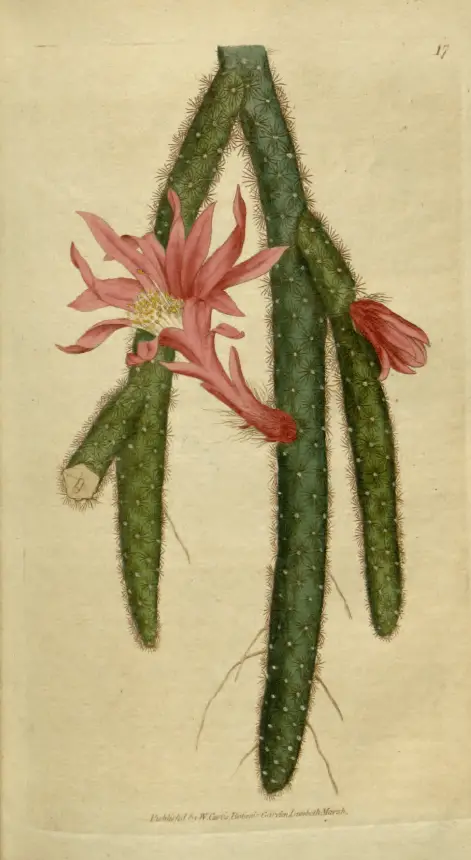Rat-Tail Cactus is one of the most popular cultivated cacti. Their trailing stems make them a perfect plant for hanging baskets. I have had one of these cacti growing in my container garden for a while now, and I love it! Its unique appearance makes my garden look much more exotic and interesting. If you thinking about adding a Rat-Tail Cactus to your plant collection, you may be wondering how to care for these plants. Fortunately, Rat-Tail Cactus is not very fussy.
Rat-Tail Cacti require full sun. If you are growing these plants indoors, place them next to a sunny window, or supplement natural light with artificial light. These plants have watering requirements similar to other succulents. Water Rat-Tail Cactus thoroughly, and allow the soil to dry completely before watering again. Rat-Tail Cactus can be grown outdoors in USDA Hardiness Zones 10a to 11b, but it is important to keep them out of frost.
The rest of this article will provide a brief history of Rat-Tail Cactus cultivation and will include a more detailed description of its care requirements.
About Rat-Tail Cactus
Aporocactus flagelliformis, which is commonly known as Rat-Tail Cactus or Creeping Cactus, is a member of the Cactaceae family. You may also see the scientific name for this plant listed as Disocactus flagelliformis in some places. This is because Aporocactus used to be a sub-genus of Disocactus. However, new research has shown that Aporocactus, which contains two plant species, is its own genus (Cruz et al., 2016). Therefore, Aporocactus flagelliformis is the correct scientific name.
Rat-Tail Cactus is native to the dry forests of southern Mexico and Central America where they grow as epiphytes or lithophytes. In Mexico, Rat-Tail Cactus tends to grow at high altitudes where temperatures drop at night.
In rural areas, the flowers of the Rat-Tail Cactus are used as a rubefacient (Díaz, 1976). Rubefacients are a type of topical medicine that reddens the skin to increase blood flow. They are commonly used to treat musculoskeletal conditions.
Rat-Tail Cactus was one of the first cacti to be introduced to European Culture in 1690 from Peru. Rat-Tail Cactus was also one of the first plants to be illustrated in William Curtis’s Botanical Magazine in 1787. The images below are scans of the original magazine.
These plants continued to be popular window plants throughout the nineteenth century and were grown to climb up the architectural supports in conservatories (Woodhead, 1991).
Near Threatened Status Of Rat-Tail Cactus
Unfortunately, the Rat-Tail Cactus has been classified as Near Threatened (NT) by the International Union for Conservation of Nature. This conservation status means that the species could be in danger of extinction in the near future, but they do not qualify for threatened status. According to an article written by the Desert Sun, Rat-Tail Cactus can no longer be found in the wild.
Rat-Tail Cactus Blooms
If the plant receives proper care, blooms will appear during the late spring to early summer. The blooms are a beautiful pink color and are about two to three inches long. Rat-Tail Cactus will produce several blooms, and each bloom lasts 3-4 days. In my experience, these plants will produce more blooms in certain years and fewer during other years.

To encourage a Rat-Tail Cactus to bloom, it is important to increase the frequency of watering during the growing season (late April to November). If you are growing a Rat-Tail Cactus indoors, take care not to overwater. The soil should be allowed to dry almost completely between waterings even during the growing season. To encourage blooming, it is also important to make sure that Rat-Tail Cactus receives enough light during the growing season.
Lighting Requirements For Rat-Tail Cactus
Rat-Tail Cactus require full sun or bright, indirect light even during their dormant period. If grown indoors, these plants should be placed next to a south-facing window (north-facing in the southern hemisphere). If you are not sure whether your Rat-Tail Cactus is receiving enough light, supplement natural light with full spectrum artificial lighting.
Suitable Temperature Range For Rat-Tail Cactus
These plants can tolerate temperatures between 40°F and 90°F. However, they should not be exposed to frost. They will do well in indoor temperatures, but you should avoid placing your Rat-Tail Cactus next to a window that is drafty or in a spot that experiences significant temperature fluctuations (e.g., a vent or fireplace).
Soil Mix For Rat-Tail Cactus
As previously mentioned, Rat-Tail Cactus grows on rocks and trees in the wild rather than in soil. However, they will grow more quickly in soil. Rat-Tail Cactus thrives in nutrient-rich, well-draining soil. A cactus soil mixed with a bit of compost is ideal, but a high-quality all-purpose potting mix will do as long as you do not overwater.
Watering Rat-Tail Cactus
Like many succulents, Aporocactus flagelliformis, or Rat-Tail Cactus, it is best to water these thoroughly and allow the soil to dry completely before watering again. However, you should water Rat-Tail Cactus more frequently during its growing season (between late April and November) to encourage blooming.
Fertilizing Rat-Tail Cactus
Rat-Tail Cactus is a fast-growing plant and will benefit from some fertilization. During the growing season, fertilize your Rat-Tail Cactus every three to four weeks a solution of half-strength liquid fertilizer. You do not need to fertilize Rat-Tail Cactus during the winter months because they are dormant.
Pest Problems Potentially Affecting Rat-Tail Cactus
In general, the Rat-Tail Cactus is resistant to pests and diseases. However, spider mites and scale insects are the most common pest problems. These pests puncture the cactus to extract plant juice. To treat an attack of spider mites of scale insects, apply an insecticidal soap or Neem Oil every couple of days for two to three weeks. Some gardeners have also found a mixture of Pyrethrum and soapy water to be an effective way to get rid of spider mites and other pests.
Snails are common pest problem for Rat-Tail Cacti living outdoors. Snails will actually eat chunks of your Rat-Tail Cactus despite the spines. Unfortunately, snail bites bites do not heal and will remain on the plant for life. The toxin in most snail repellents is metaldehyde which is a chemical that will kill dogs, squirrels, and birds. For this reason, it is better to use a product like Sluggo which contains iron phosphate. The iron phosphate will dehydrate the snails and encourage them to move along.
Repotting Rat-Tail Cactus
Ideally, Rat-Tail Cactus should be repotted every year. However, you do not necessarily have to put your plant in a new or bigger pot. The main objective of repotting is to give the plant some fresh soil with more nutrients. The best time to repot is after flowering.
I strongly recommend wearing leather gloves when repotting your Rat-Tail Cactus. Their bristly, fine spines can easily get stuck in your skin. In my experience, this feels like a more uncomfortable version of a splinter.
Propagating Rat-Tail Cactus
Rat-Tail Cactus can be easily propagated from stem cuttings. Simply take a 6-inch stem cutting and allow the cutting to dry out for a couple of days. Then place the segment in a pot of fresh soil and keep the soil damp. If necessary, use a wooden stick to support the segment. The cutting will root within a few weeks.
It is possible to grow Rat-Tail Cactus from seeds, but it is difficult. In the wild, only a small percentage of seeds will produce an adult plant. Watering is crucial during the first few weeks. A seedling that is one week old will die of dryness after only three days without water.



